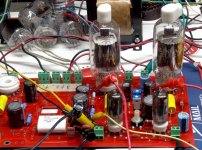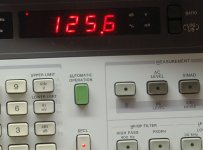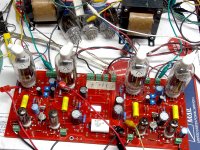I see no reason why they wouldn't work, unless the charging current of the downstream caps exceeds the 3 Amp drain current spec. 2SK2700's are becoming extremely scarce, so I am saving the few that I have for other experiments. I have found the 2SK2700's fairly easy to blow, but just about any semiconductor becomes a fast blow fuse at 400+ volts. When they fail they short out, bad for the downstream caps.
Good point. IRF840's may be a better choice. I don't intend to go beyond 450v on purpose.
Whitelabrat. Someone that works in the plant where I work announced today that he is leaving (by choice!). He got a job at the APL starting in early December.
The more the merrier! Very sweet gig.
I wonder if this design can be upgraded by adding some powerdrive solution before the powertubes. Gary Pimm is thinking of trying this out on his famous Tabor which, as you know, is also equipped with a pentode driver and local feedback.
See here: http://www.diyaudio.com/forums/tube...ive-pp-amp-local-feedback-pentode-driver.html
I am asking because I plan to build the 6cb6 - EL34 amp you see in this thread (with the 807 tube). I found the design in Glass Audio (many years ago) and it looks looks a bit similar the Millett amp. It misses the splitter though, I am thinking of adding a concertina with the ecc40 (= E80CC).
See here: http://www.diyaudio.com/forums/tube...ive-pp-amp-local-feedback-pentode-driver.html
I am asking because I plan to build the 6cb6 - EL34 amp you see in this thread (with the 807 tube). I found the design in Glass Audio (many years ago) and it looks looks a bit similar the Millett amp. It misses the splitter though, I am thinking of adding a concertina with the ecc40 (= E80CC).
@ ~2V out I'm at 0.07% THD in one channel and 0.4 % in the other. Thoughts here? Tube to tube variation?
Probably. Pete uses the tubes' nonlinearity to provide some distortion cancellation, which means that tube selection is important for best performance.
Beam Triodes (35 watt monsters with a Mu of 300) I have several and haven't made them sound good yet. I believe that A2 will be required, so I may sky wire in some mosfet drivers.......The output tubes are being driven into AB2. Yes, the grids go to +15 volts. Now there are two reasons to stuff some mosfets in this thing.
I wonder if this design can be upgraded by adding some powerdrive solution before the powertubes.
I am going to find out. I believe that this amp would benefit from PowerDrive, so one of the experiments that I plan to do is to sky wire in some mosfets. It might be a week or two before I get back to it though. It doesn't look too hard to do, but I have to fix the toasted parts and modify the power supply first.
Probably. Pete uses the tubes' nonlinearity to provide some distortion cancellation, which means that tube selection is important for best performance.
So with a bit of 'musical tubes' on the input side I was able to get the distortion and gain numbers for each channel dialed in. Now @ 1 W out I'm looking at ~.45% THD in each channel. ~30 WPC @ 5% THD. No global feedback.
The above came with some dialing in of the a few voltages. 435 on the plates, swapped out C6 for a 500V metal can Sprague. With the B+ hotter I was pushing the max plate voltage on the 6CB6's so swapped out R48 and R49 for 10k resistors to bring that down to ~200V from ~300.
http://www.flickr.com/photos/duganj/4080956544/
At this point I think I ready to move on to actually building a chassis for the thing.
Last edited:
I replaced the missing resistor, and exploded cap, and changed the same parts in the good channel since they suffered the same voltage overdose that the exploded ones did. The caps were the exact same kind as before. I did swap R48 and R49 for 10K 3 watt parts so they would be harder to fry and lower the voltage on the 450 volt caps.
I fired the board up at 450 volts and all was well. I turned the knob to the right until the voltage across the exploding capacitor read 450 volts. The power supply was at 520 volts. It would take some bigger resistors or a real regulator to allow cranking the B+ up farther. I don't have time for this right now.
With the 6JN6's in place I still saw over 70 WPC at 520 volts. The distortion at 1 watt is 0.7% without GNFB.
I had a few minutes to play, so what to do if I can't turn up the voltage any more? Well, I picked the biggest looking sweep tubes in the junk box, plugged them in (remember to remove R3 and R6 unless you want to watch them explode), and crank them up.
The tubes are 6HF5 (not a cheap tube) and they are compatible in this board with no modification. I set the power supply back to 520 volts ans flipped the switch. The power and distortion is the same as with the 6JN6's. This is expected.....until I change the load impedance. I moved the 8 ohm load over to the 16 ohm tap to reflect a 3300 ohm P-P load to the tubes. The 6JN6's could not drive this load without glow and distortion. These guys can!
I cranked the drive up until the output just started to clip. How much power? Only 125 watts at 4.5% distortion. The OPT's that are in place were neven meant to deal with this kind of power, so if I get time this weekend, I will drag the big Plitrons out of their box.
I fired the board up at 450 volts and all was well. I turned the knob to the right until the voltage across the exploding capacitor read 450 volts. The power supply was at 520 volts. It would take some bigger resistors or a real regulator to allow cranking the B+ up farther. I don't have time for this right now.
With the 6JN6's in place I still saw over 70 WPC at 520 volts. The distortion at 1 watt is 0.7% without GNFB.
I had a few minutes to play, so what to do if I can't turn up the voltage any more? Well, I picked the biggest looking sweep tubes in the junk box, plugged them in (remember to remove R3 and R6 unless you want to watch them explode), and crank them up.
The tubes are 6HF5 (not a cheap tube) and they are compatible in this board with no modification. I set the power supply back to 520 volts ans flipped the switch. The power and distortion is the same as with the 6JN6's. This is expected.....until I change the load impedance. I moved the 8 ohm load over to the 16 ohm tap to reflect a 3300 ohm P-P load to the tubes. The 6JN6's could not drive this load without glow and distortion. These guys can!
I cranked the drive up until the output just started to clip. How much power? Only 125 watts at 4.5% distortion. The OPT's that are in place were neven meant to deal with this kind of power, so if I get time this weekend, I will drag the big Plitrons out of their box.
Attachments
Holy *&%(*
What a setup!
Way to go George.
With all the tubes I have I should have something that would work in that board. I need to go back to the schematic and review it..
What a setup!
Way to go George.
With all the tubes I have I should have something that would work in that board. I need to go back to the schematic and review it..
I have been working on the Simple P-P manual for most of the evening, but when Sherri announced that she was going to Walmart with one of her friends, I got this little thought. What does a 250 watt tube amp sound like?
Well, the obvious answer is LOUD, which is very true, and I must admit to having the volume control dimed for over an hour with a scope across the speaker leads. I never saw the amp clip once. I am sure that Petes setup has plenty of gain for driving the 6JN6's to 18 WPC from a CD player, but I can't achieve clipping with my CD player with the 6HF5's that are in there now. I did capture some transients on the scope that were over 80 volts P-P which is in the 100 watt range so the amp is plenty powerful, and maybe you don't want (or need) to run it into clipping.
I played this thing LOUD for nearly 2 hours. I fed it everything from Ozzy to Enya, and I couldn't find any music that it didn't like. It rocks very well. Trumpet (Dave Brubeck) and Sax (Candy Dulfer) are very realistic. Loreena McKennitt's voice can sound positively nasty on some amps, but sounded clean here even at insane volume levels.
The amp cranked at 520 volts on the B+ for 2 hours without incident. Nothing was hot at turnoff except for the output tubes (of course) and the 10M45's. I will add a small heat sink to them eventually.
I had been thinking of all sorts of experiments that I wanted to do with this thing, but after listening for a while, I started thinking about leaving it alone and finding a suitable power supply. I really want to see what this thing will do with my big speakers, but there is no way I can move them into this room, or move 3 big power supplies into the living room.
I made these observations. The current drawn from the 150 volt screen supply is dependent on the plate supply voltage. With a low plate supply voltage (under 400 volts) I saw the current meter on the screen supply up around 40 mA, but with 520 volts on the plates, the total current on the screen supply is about 15 mA. The bias supply has been set on -75 volts since initial turn on. This may be the reason for the warm 10M45's, and the total current drain is 40 mA. A lower voltage would probably do fine, but excess negative voltage is good when cranking things far beyond their intended operating points. The current meter on the plate supply was over 600 mA when both channels were driven to 125 watts, but never crossed over the 300 mA line when played at full tilt. It was around 200 mA at idle.
Looking through my collection of power transformers brought up two possibilities. I have an Antek 4TK400 which looks like the obvious choice since I have already seen it make about 530 volts at 400 mA. It also has two bias taps for a full wave bias supply. Then I started dreaming up some really geeky looking enclosure for an "engineers amp" and that big black and blue transformer pirated from an old Tek scope looks right at home........
Well, the obvious answer is LOUD, which is very true, and I must admit to having the volume control dimed for over an hour with a scope across the speaker leads. I never saw the amp clip once. I am sure that Petes setup has plenty of gain for driving the 6JN6's to 18 WPC from a CD player, but I can't achieve clipping with my CD player with the 6HF5's that are in there now. I did capture some transients on the scope that were over 80 volts P-P which is in the 100 watt range so the amp is plenty powerful, and maybe you don't want (or need) to run it into clipping.
I played this thing LOUD for nearly 2 hours. I fed it everything from Ozzy to Enya, and I couldn't find any music that it didn't like. It rocks very well. Trumpet (Dave Brubeck) and Sax (Candy Dulfer) are very realistic. Loreena McKennitt's voice can sound positively nasty on some amps, but sounded clean here even at insane volume levels.
The amp cranked at 520 volts on the B+ for 2 hours without incident. Nothing was hot at turnoff except for the output tubes (of course) and the 10M45's. I will add a small heat sink to them eventually.
I had been thinking of all sorts of experiments that I wanted to do with this thing, but after listening for a while, I started thinking about leaving it alone and finding a suitable power supply. I really want to see what this thing will do with my big speakers, but there is no way I can move them into this room, or move 3 big power supplies into the living room.
I made these observations. The current drawn from the 150 volt screen supply is dependent on the plate supply voltage. With a low plate supply voltage (under 400 volts) I saw the current meter on the screen supply up around 40 mA, but with 520 volts on the plates, the total current on the screen supply is about 15 mA. The bias supply has been set on -75 volts since initial turn on. This may be the reason for the warm 10M45's, and the total current drain is 40 mA. A lower voltage would probably do fine, but excess negative voltage is good when cranking things far beyond their intended operating points. The current meter on the plate supply was over 600 mA when both channels were driven to 125 watts, but never crossed over the 300 mA line when played at full tilt. It was around 200 mA at idle.
Looking through my collection of power transformers brought up two possibilities. I have an Antek 4TK400 which looks like the obvious choice since I have already seen it make about 530 volts at 400 mA. It also has two bias taps for a full wave bias supply. Then I started dreaming up some really geeky looking enclosure for an "engineers amp" and that big black and blue transformer pirated from an old Tek scope looks right at home........
Attachments
Some more novice questions.
What value potentiometer can I use as a volume control on the input to make the amp integrated, Or will I need to use an active pre-amp?
What value potentiometer can I use as a volume control on the input to make the amp integrated, Or will I need to use an active pre-amp?
I've got my board stuffed (excepting the MOSFETs) and am awaiting my Edcor PT. I'll be using a pair of Z-565 OPTs with these and putting them up against my modified-to-the-gills ST35 amp to see which drives my Heresy IIs the best...I'm thinking the DCPP will probably win.
-D
-D
Careful, the Z-565 is a really, really delicate little flower compared to the Edcor
Cheers!
Pete and I already discussed offline - at the stock DCPP voltages the Z-565 should have more than enough headroom given how overbuilt it is. Not to mention for sound quality, there's simply no comparison between the Dynaco iron and Edcor (not that Edcor is bad, but that the Dynaco iron is just that damn good). 😀
However, I do appreciate the warnings - last thing I want to do is toast my vintage 1963 transformers. 😱
-D
Hi,
This bring a new question. Are the reproduction Z-565 @ $70 and larger ones, 35W rating A-470 @ $95 , 60W rating A-431 @ $120 from Triode and others as good as the old ones? They do say they are reproductions. The bigger ones might be suitable for bigger tubes as George mentioned. www.triodestore.com
Thanks
Randy
This bring a new question. Are the reproduction Z-565 @ $70 and larger ones, 35W rating A-470 @ $95 , 60W rating A-431 @ $120 from Triode and others as good as the old ones? They do say they are reproductions. The bigger ones might be suitable for bigger tubes as George mentioned. www.triodestore.com
Thanks
Randy
Last edited:
Here are a few photos Of my progress.
I cheated and had the top panel made by Schaeffer Ag (front panel express here in Europe).
An externally hosted image should be here but it was not working when we last tested it.
Hi blueworm,
how much did it cost you to get the panel done?
More of less €75 including shipping to Spain. Bare in mind there are no countersinks, those where €1 each which is way too much for my pockets. 🙂Hi blueworm,
how much did it cost you to get the panel done?
I would expect a 100k audio taper volume potentiometer would do.
Thanks for the reply whitelabrat, is there a technical reason for that value pot?
I kinda have a 50K Alps blue velvet handy could I use this adding a resistor in some creative mannner? Or could it be enough as is?
Z-565 should have more than enough headroom given how overbuilt it is.
I have a Z-565 bobbin here beside me for reverse engineering and the primary is what... AWG#36...38?
No, it is not overbuilt.
Cheers!
Last edited:
- Home
- Amplifiers
- Tubes / Valves
- Posted new P-P power amp design




